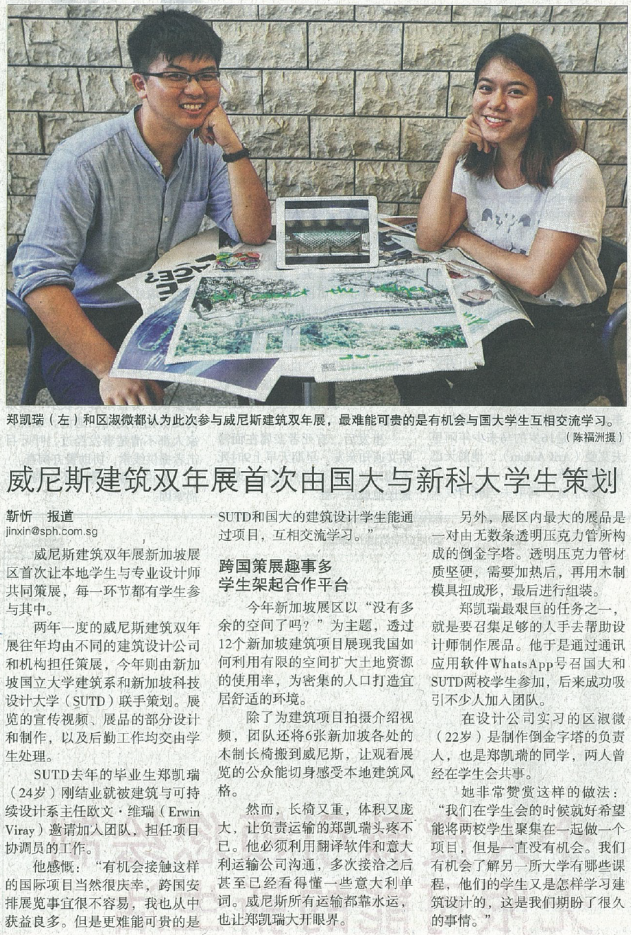Lianhe Zaobao, 3 Jul 2018, First time NUS and SUTD students planned for the Venice Architecture Biennale Exhibition (translation)
This is the first time the Singapore Pavilion at the Venice Architecture Biennale was co-organised by local students and professional designers, with students participating every step of the way.
The biennial Venice Biennale was curated by different architectural firms and institutions in the past years. This year, the architecture departments of both the National University of Singapore (NUS) and the Singapore University of Technology and Design (SUTD) jointly planned and organised the Singapore Pavilion. The promotional videos of the exhibition, parts of the design and production of the exhibits, as well as the logistics, were all managed by the students.
Kendrick Tay (24), who graduated from SUTD last year, was hired by Architecture and Sustainable Design Head of Pillar, Prof Erwin Viray to join the team as a project manager/coordinator.
He said with emotion: "I am very fortunate to be able to participate in this international project. Making arrangements for such global exhibitions is not easy and I have benefited a lot from this experience. But what is more valuable is that SUTD and NUS architecture students can communicate with each other through this project and learn from one another.”
Multinational curatorial fun; Students set up a cooperative platform
This year’s Singapore Pavilion asks the question “No more free space?” as its theme, and the exhibition features 12 Singapore-based projects that showcase how in spite of the limitations in space, we have created a liveable and comfortable environment for our dense population.
In addition to taking an introduction video for the architectural projects, the team also had to transport six benches from Singapore to Venice to allow viewers of the Singapore Pavilion to experience the local architectural style.
However, the chairs are bulky and heavy and caused Kendrick a lot of headache as he had to find a way to ship them over to Venice. He had to use translation software to communicate with the Italian transportation company, and after contacting them multiple times, he now even understands some Italian words. Transportation in Venice is done via the waterborne transport, which was an eye-opener for Kendrick.
The largest exhibit at the Pavilion is a pair of inverted pyramids made of acrylic. The transparent acrylic tube is made of a hard material and needs to be heated up, twisted into shape via a wooden mold, before finally being assembled.
Kendrick’s most arduous task was to gather enough assistants to help the designer produce the acrylic installation. He used communications app WhatsApp to appeal to NUS and SUTD students to participate and finally managed to attract a decent number of students to join the team.
Intern at the firm fabricating the inverted acrylic pyramid is Inez Ow (22), who was also in charge of work done on the acrylic installation. She is also Kendrick’s classmate and they were both previously part of the student council.
She is very appreciative of this approach: “We were hoping to bring together students from the two universities to do a project while we were in the student council, but could not find the opportunity. With this project, we got to understand what architectural courses the other university’s students studied, and this is something we have looked forward to for a long time.”
